Florida Animals in Miami Area
Contents
Thanks to the year-round nice and warm weather, the native animals and plants in the Miami area grow and flourish, resulting in some of the most beautiful gardens. Well before Florida was recognized for its theme parks, people would come and stay in Miami Beach to witness the magnificent animals and plants in the Miami area. Florida’s vegetation is varied; there are up to 7 floral zones.
- Flatwoods: open forests with an abundance of flowers (up to 60 species of orchid).
- Scrublands: mostly small sand pines.
- Savannas: American lotus, water hyacinth, and water lettuce.
- Grassy swamps: The Everglades
- Salt marshes: Mangroves
- Hardwood forest or Hammock: Trees growing on wet soil and in marshlands.
- Pinelands
There are also some native species, specific to Florida and the Florida Keys. Some of these species are endangered and, therefore, protected. The mockingbird, one of the native birds, was named the state bird in 1927. The alligator is maybe one of South Florida’s most iconic native species. The most known and common fauna found in Florida include:
Alligators and crocodiles
These are probably some of the most iconic animals in this region. They look alike and are often confused. South Florida is the only place on earth where crocodiles and alligators cohabitate. They are, however, two distinct reptiles.
- The American Crocodile is only found in South Florida (Everglades National Park, Key Biscayne, and the Florida Keys).
- The American Alligator is found all over Florida and the southern states of the US.
If you’re looking to spot some of the most impressive reptiles in the United States, then you don’t have to look further than Miami, Florida. With its unique ecosystem, Miami is home to many alligators and crocodiles that make it a wonderful sight for any visitor.
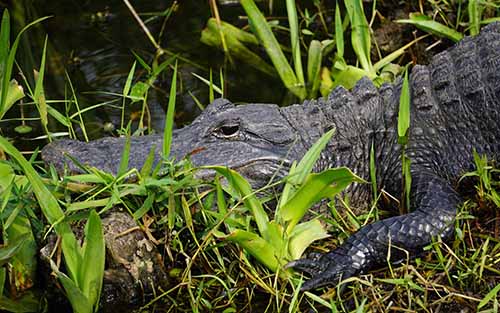
The most popular place to view alligators and crocodiles is at Everglades National Park, which covers much of Southern Florida. Here you can take a tour around the park on an airboat, keeping your eyes open for any of the large reptiles that appear. Alternatively, you can rent a kayak and paddle through the park’s waters, offering you a closer encounter with the animals. Just remember to maintain a safe distance between yourself and any wildlife you come across!
For those who prefer to observe the animals from a distance, the Anhinga Trail at Everglades National Park features numerous alligators sunning themselves along the path. Visitors can stroll down this shaded boardwalk and enjoy beautiful views in an environment where these ancient creatures are as comfortable as can be.
Another great place to observe alligators and crocodiles is Jungle Island, an entertainment park located near Downtown Miami. Here, visitors can get close-up views of both alligators and crocodiles from their holding areas and during daily shows featuring trained professionals. It’s a great opportunity for kids and adults alike to learn more about these amazing creatures.
No matter where you go, always remember to respect the animals’ territory and keep your distance if you happen to come across one unexpectedly. Alligators and crocodiles may be beautiful, but they can also be quite dangerous if not handled carefully.
Miami Turtles
The beaches of Miami are home to a variety of sea turtles. Let’s take a look at four of them – the Green Sea Turtle, Loggerhead Sea Turtle, Hawksbill Sea Turtle, and Leatherback Sea Turtle.
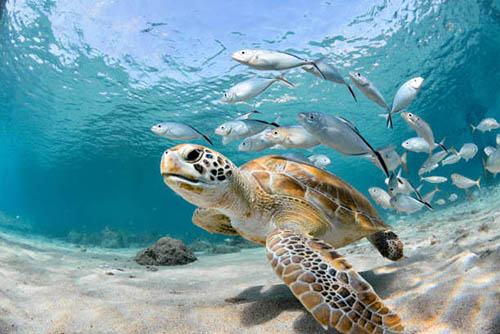
Green Sea Turtle
The Green Sea Turtle, or Chelonia mydas, is an endangered species that call South Florida it’s home. It can be found in shallow seagrass beds and coral reefs off Miami’s coast. They are distinguished by their shells, which are green on top and yellow underneath. The age and size of these turtles vary, with adults typically measuring around 3 to 4 feet in length and weighing up to 500 pounds. This species rarely comes ashore and its diet consists of seagrasses and algae.
Loggerhead Sea Turtle
The Loggerhead Sea Turtle, or Caretta caretta, is also an endangered species that lives in South Florida’s marine habitats. These turtles have oval-shaped shells that range from yellow to brownish-red in color. Adult Loggerheads usually measure 2 to 3 feet long and can weigh up to 350 pounds. Unlike their green counterparts, they have been known to come ashore to nest and their diet consists of crabs, shrimp, jellyfish, and fish among other things.
Hawksbill Sea Turtle
The Hawksbill Sea Turtle, or Eretmochelys imbricata, is a critically endangered species that have taken shelter along Miami’s shorelines for many years. These turtles possess unique-looking curved shells with patterns of yellow and tan. They tend to be relatively small, averaging around 2 feet in length. They are well-known for their diet which consists mainly of sponges found amongst the coral reefs.
Leatherback Sea Turtle
The Leatherback Sea Turtle, or Dermochelys coriacea, is the world’s largest species of turtle and it is also the most widely distributed turtle species in the world. These turtles have large black shells and weigh between 600-2,000 pounds. They feed on jellyfish, soft coral, and other invertebrates that are usually found short distances away from shore. They are named after their leathery skin covering as opposed to a hard shell like other sea turtles have.
These four species of sea turtles play an essential role in maintaining healthy oceans by consuming harmful microorganisms that could otherwise harm native fish populations. As such, it is important we take action now to ensure their survival so future generations can enjoy these majestic creatures.
Manatees (sea cow)
West Indian Manatees are large herbivorous marine mammals. Their average length is around 9.8 ft and can weigh 800 to 1,200 lbs. They are found in the Caribbean and the Gulf of Mexico. The mermaid folklore is supposedly linked to the manatee.
The warm, shallow waters of Biscayne Bay provide an ideal habitat for the species and offer excellent opportunities for individuals to encounter them in their natural environment.
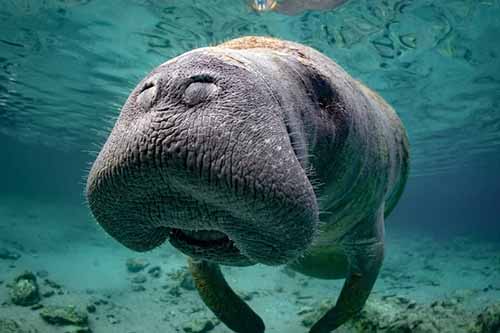
The warm water of the bay creates a safe and nourishing environment that provides plenty of food sources for manatees while also providing shelter and protection from potential predators. Manatees are particularly fond of areas where there are plentiful seaweed beds, as they enjoy grazing on them. Many manatees can be found in the shallower estuarine waters around Miami.
The best times to spot manatees in Miami are during summer months when the temperatures are higher and more manatees are drawn to the warmth of Biscayne Bay’s waters. They can often be found in mangrove habitats, where boaters and visitors should be vigilant to avoid disturbing them.
Manatee viewing areas such as Manatee Bay Park and Manatee Lagoon have been established to give people the opportunity to enjoy exceptional views of the amazing creatures without causing any disturbance. The nearby Stiltsville area also has abundant mangrove environments and is especially attractive to manatees due to its abundance of seagrass and other marine life.
For those interested in learning more about manatees, guided tours, boat trips, and educational programs are all available at various locations around Miami. By learning more about these amazing animals, we can help ensure their continued survival in their natural habitats.
Miami Birds
With its tropical climate and coastal location, Miami has become the perfect home for a variety of avian species. From exotic Roseate Spoonbills to majestic Bald Eagles, these birds bring wildlife back into the city and make Miami an even more beautiful place. Here is a comprehensive guide to some of the most notable species of birds you can find in the area.
Roseate Spoonbill
The iconic pink-feathered Roseate Spoonbill is one of the most recognizable birds in Florida. These wading birds have long, spoon-shaped bills which they use to filter their food from tidal pools and swamps. They are often found along Miami’s south-eastern coastline, where they hunt for shrimp, mud crabs, and other invertebrates. In addition, they build large nesting colonies in mangrove islands throughout the region.
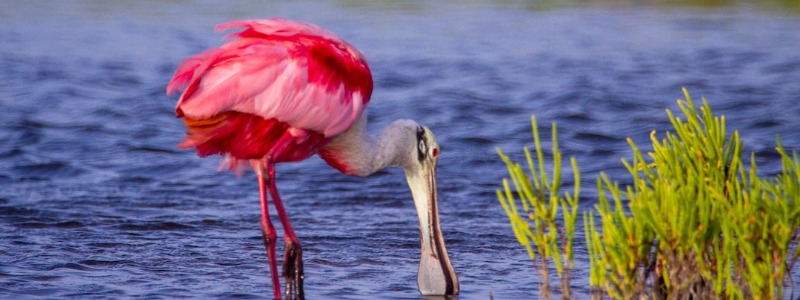
Great Egret
The stately Great Egret is a common sight in many of Miami’s wetlands and marshes. With its striking white feathers and black legs, this bird stands out amongst its peers. Great Egrets are expert hunters, with razor-sharp eyesight that helps them spot small prey from afar. They usually hunt alone, although occasionally they will gather around water bodies looking for food.
Wood Stork
Found near inland fresh and saltwater bodies, the Wood Stork is another impressive wading bird found in Miami. With its large wingspan and snowy-white feathers, it stands out from other birds in the area. Wood Storks feed mainly on fish and frogs, although they can also consume crustaceans and small mammals. They often nest in cypress trees or on rocks along shorelines.
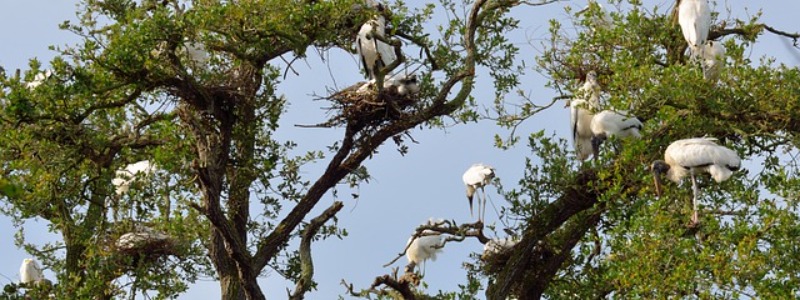
Burrowing Owl
Small but feisty, the Burrowing Owl is another interesting bird you can find in Miami. Unlike many other bird species in the region, Burrowing Owls don’t dwell in trees. Instead, they make nests underground in abandoned burrows or cavities. Despite their size, they are fierce predators, mostly eating insects while also hunting small mammals such as mice or rats.
Osprey
Often seen soaring above Miami’s urban areas, Ospreys are large raptors with an unmistakable silhouette. They feed mainly on fish, sea trout and various sorts of freshwater fish which they catch mid-flight. In addition, Ospreys build huge nests out of sticks at the top of tall trees or utility poles.
Bald Eagle
An iconic symbol of the United States, the Bald Eagle can be occasionally spotted hunting over Lake Okeechobee or other coastal areas in South Florida. This large bird has sharply hooked yellow beaks and powerful talons which allow them to easily capture its prey. Bald Eagles use their keen vision to spot hosts of fish swimming just under the surface of the water.
Red-tailed Hawk
Another apex predator that frequents Miami’s skies is the Red-tailed Hawk. With its reddish-brown plumage and long wingspan, it is easy to identify this predator from afar. It typically dwells in thick forests but can sometimes be seen flying above open fields in search of rodents or small birds.
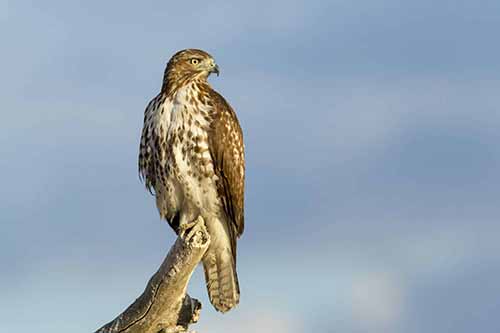
Black Vulture
This large scavenger is not as attractive as other birds in South Florida, but it still deserves credit for being resilient enough to survive amidst the hustle and bustle of the city streets. Black Vultures feed on carrion and garbage, so they are quite used to our presence. You can often find them perched atop streetlights or telephone wires, especially near large dumpsites.
American White Pelican
This incredible white bird inhabits lakes, lagoons, and shallow streams throughout South Florida. American White Pelicans have giant pouches underneath their beaks which they use to scoop up fish while swimming through the water. When available, they also eat aquatic plants and amphibians. These pelicans form large flocks and can often be seen between December and April near Lake Okeechobee.
Magnificent Frigatebird
Although technically not a pelican, the Magnificent Frigatebird is still an impressive sight you can encounter when visiting South Florida’s waterways. These dark-colored seabirds soar above oceans and estuaries feeding on fish, reptiles or even baby turtles from time to time. As a result of their alternating brown and black markings, they stand out from other aquatic birds in the area.
Florida Panther
This is a critically endangered relative of the cougar found in the low tides, palm forests, and swamps of South Florida. The number of living Florida panthers is estimated to be between 80 and 100. It represents 5% of its historic range. In 1982, it was named Florida’s state animal.

The Florida Panther is an endangered species found only in South Florida. However, visitors to Miami now have the opportunity to see this magnificent animal, as Zoo Miami is home to a Florida Panther habitat and exhibit. Visitors can observe the panthers up close, learning more about their behaviors, habits, and threats to their population. A dedicated team of experts cares for the animals, ensuring their health and safety. In addition to seeing a live Panther, Zoo
Miami also has educational displays about the species’ plight and what people can do to help protect them. No visit to Miami would be complete without stopping by to witness this rarely-seen animal in its natural habitat.
Gray Fox
The Gray Fox (Urocyon cinereoargenteus) is a remarkable species with coats of steel-gray and distinct reddish hues. It is these red markings that have given it its alternative name – the Red-Sided Fox – and can easily be mistaken for the Red Fox (Volpes volpes). Though both inhabit Florida, only the Gray Fox is native to the region, where it prefers the thickets of woodlands in order to avoid contact with humans.

The Gray Fox is nocturnal, and so a rare sight for many. Although it usually remains hidden away in its preferred habitat there are some fortunate enough to witness these elusive mammals whilst on an evening stroll. This photograph was taken at Crystal Lake Sand Pine Scrub Natural Area – a 25-acre pocket of wilderness situated within Pompano Beach’s urban developments. Similarly, they can also be found amongst similar suburban habitats such as Seacrest Scrub Natural Area in Boynton Beach.
Their diet consists primarily of small mammals such as rabbits, mice, and rats, but can also include birds, reptiles and amphibians, insects, and berries. The Gray Fox faces an uncertain future due to the reduced habitat available in South Florida, however, this species has adapted to more human-disturbed environments. With ongoing efforts to protect suitable habitats and preserve these unique animals, we may yet have a chance of seeing this beautiful species for years to come.
Florida Black Bear
This species lives mostly in forested areas and have therefore seen recent habitat destruction. It is a threatened species. The main cause of death is road accidents (which account for 89% of deaths since 1994). They are mainly solitary creatures. Those living in South Florida are the only subspecies to live in a sub-tropical region.
The Zoo Miami, formerly known as the Miami MetroZoo, is an excellent destination for anyone looking to get up close and personal with these majestic creatures. The Zoo is home to several species of black bears, including the Florida black bear.
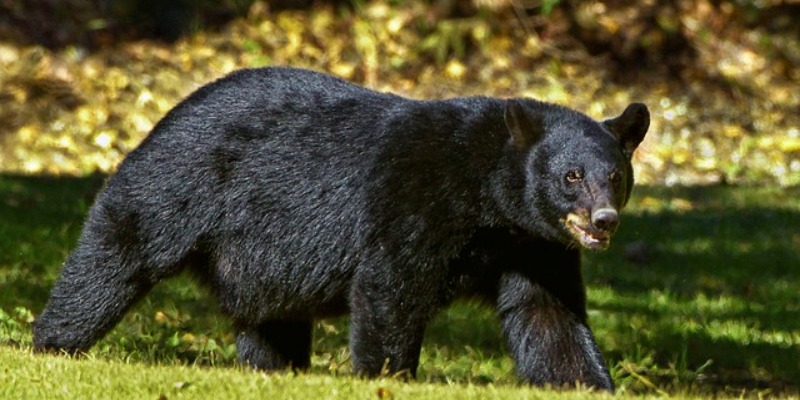
Visitors can watch the black bears play in their natural habitat through a safe, simulated environment. Guests will also learn about the unique diet needs, habits, and behavior of a black bear up close. Additionally, Zoo Miami offers educational programs that help children and adults understand how to protect these animals from the ills of human civilization.
So if you’re looking to get some quality time in with Florida’s black bear population, head over to Zoo Miami! You won’t be disappointed.
Bottlenose dolphin
This is probably the most iconic Florida animal of all. Dolphins are very intelligent and friendly sea mammals. If you have always dreamed of swimming with dolphins, there are plenty of possibilities in Miami for you to do so.
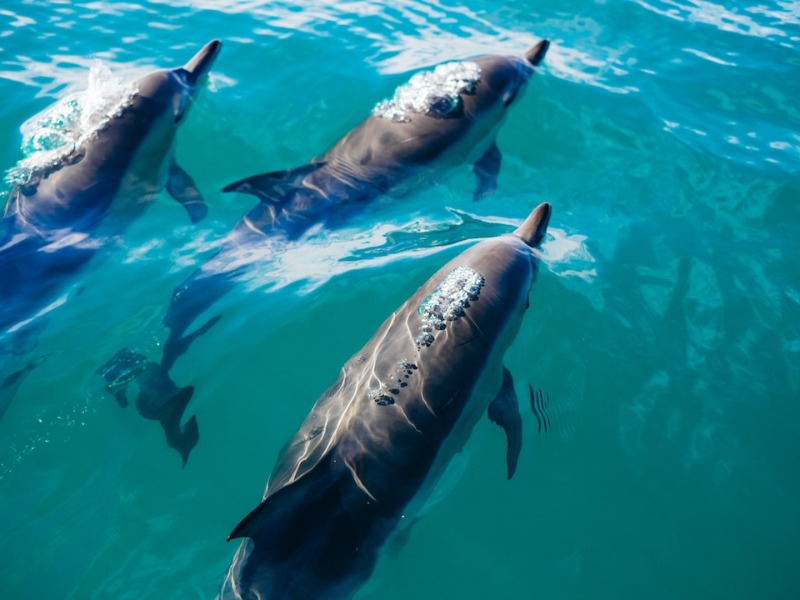
Popular spots to see Bottlenose dolphins include Biscayne Bay, Crandon Park, Key Biscayne, and Government Cut. It’s also worth considering taking a tour with one of the many local companies which provide dolphin-spotting excursions – an excellent way to get even closer to the animals without getting wet!
It’s important to remember that these are wild animals so if you do spot any make sure to maintain a respectful distance. Never approach, feed, or attempt to touch them as this can be both dangerous and stressful for the dolphins. Enjoy them from a safe distance and you’ll have an unforgettable experience!
Killer Whale (Orca)
These are found in the waters of Florida as well as in the numerous amusement parks. Despite their scary name, they aren’t a threatening species. The social and vocal behaviors of Orcas have been described as being a manifestation of culture.
The first place to visit is the Miami Seaquarium. Home to numerous marine creatures, including bottlenose dolphins and sea lions, it’s also known to harbor an occasional orca. The facility offers several opportunities to watch these amazing animals as they swim and play, making it a great spot for families looking for a memorable experience.
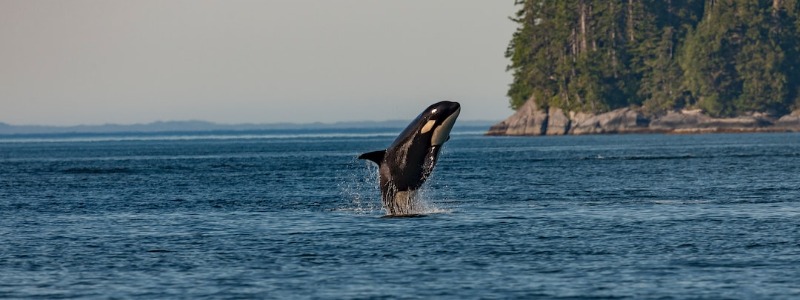
Another option is Biscayne Bay, National Park. While usually not home to orcas, it’s known to be the breeding ground of numerous other types of whales and dolphins. During certain times of the year, it’s possible to view pods of orcas swimming in the bay so if you’re lucky, you might get to spot one while out on the boat.
One final spot worth checking out is Peanut Island. This small island off the coast of Palm Beach is home to a range of marine life and has been known to be visited by orcas from time to time. You may even get lucky enough to see them breaching out of the water! Just taking a boat ride around the island can be quite rewarding and may offer excellent views of these magnificent creatures.
So if you’re looking for orcas during your stay in Miami, then make sure to check out these spots for the best chances of seeing them.

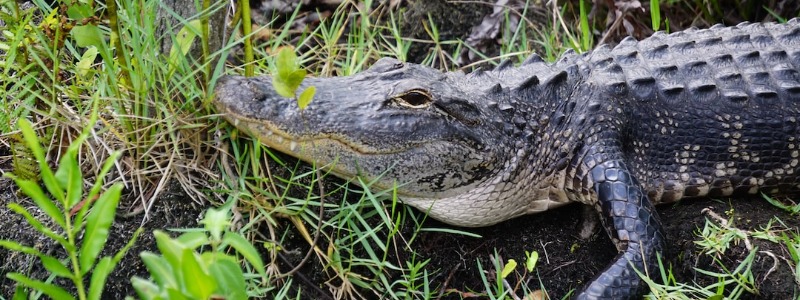
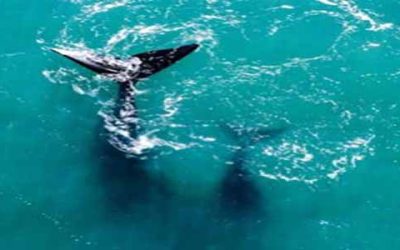



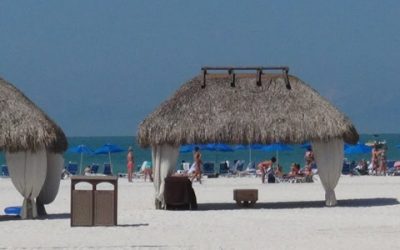
0 Comments